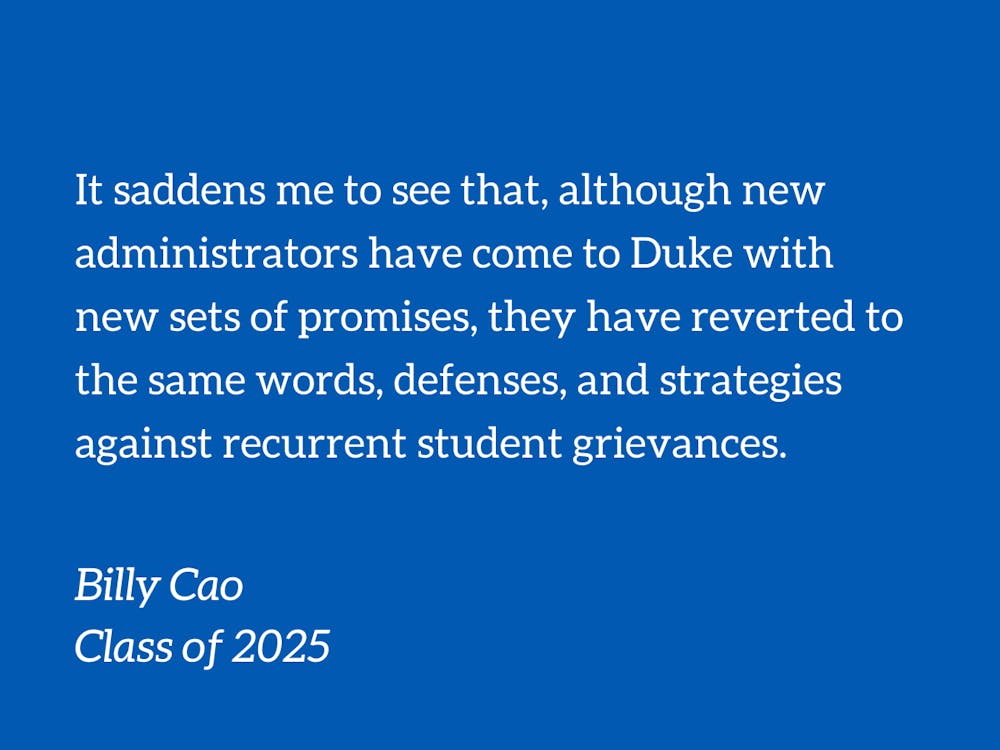Sexual violence resources at Duke are reactionary, says Eden Schumer, the founder of SHAPE, because they “do nothing to reduce the number of people who will be [affected] in the future.” Drawing on her criticism, the Community Editorial Board urged the university to “offer more of its abundant financial resources to SHAPE” so that it can initiate more prevention and education programs.
Administrators are keen to accept this line of criticism and have, in effect, delegated prevention tasks to student organizations. Speaking with the Editorial Board in 2017, former president Richard Brodhead had already rejected “quick administrative fixes,” or any administrative fix for that matter, and emphasized that solutions to sexual assault demand “the continued action and efforts of groups and individuals on campus.”
An insidious division of labor has gradually taken shape at Duke: prevention is the responsibility of student groups, while post-sexual assault intervention is the exclusive domain of the administration. We must not accept this dichotomy. We ought to ask ourselves, is there a clear distinction between prevention and intervention, or is it true that they are so inextricable that we cannot talk about one without the other? Moreover, although students and administrators are both responsible for establishing this dichotomy, who stands to gain?
Institutional resources and policies, as reactionary as they are, dictate the political context within which campus assault occurs. As such, intervention is the target par excellence of prevention. If we listen to survivors who have turned to the reporting process at Duke, we learn that the stakes are unfairly high – they risk losing not only “the coping skills they’ve worked so hard to incorporate” but also “any confidence that their experiences are legitimate.” Students are not merely crying wolf, then, when they claim that sexual assault is underreported at Duke. But whereas administrators tend to situate this problem within survivors or the culture at large, I stress that defective interventional policies play a far more substantial role. In any case, I do not understand how a disciplinary process that fails to hold most perpetrators of gender violence accountable is not relevant to the perpetuation of that very act. How is reforming the broken process not part of the solution?
On the other hand, prevention is intervention par excellence against perpetrators and students who excuse the behaviors of perpetrators. Education programs bring into consciousness how misogyny is instantiated on campus. Good education also helps students understand what makes wrongful sex wrong. The man who assaults a woman should be condemned not only for his maintaining power over that person. We also have to acknowledge that he objectifies women qua women. That is, he thinks of women as a class as something to be taken, something to be had. Framing instances of assault within the culture of male domination invariably leads to difficult conversations, uncomfortable confrontations, and even the breaking of relationships, all of which may be important interventions that the university is in no position to offer.
Too often we formulate sexual assault as a public health issue – I am guilty of it too – and I suspect this is the root of the dichotomy. Even Schumer asks, “why can’t [Duke] address sexual assault as the public health issue and epidemic it is?” However, gender violence is embedded in cultural, political, ethical, and historical contexts in a way that other public health issues, such as infectious diseases, are not. Moreover, prevention and treatment make sense as disparate epidemiological concepts but are not applicable to survivors and perpetrators. Lastly, every time that we invoke statistics, we risk reducing the irreducible, that is, survivors’ first-person lived experiences.
In writing this article I surveyed, to the best of my ability, Opinion pieces related to sexual assault in The Chronicle over the past seven years. It saddens me to see that, although new administrators have come to Duke with new sets of promises, they have reverted to the same words, defenses, and strategies against recurrent student grievances. Consequently, little progress has been made. In particular, the myth that prevention relies on individuals and groups, not the university, reflects a general unwillingness to take any action other than those required by federal laws. If I am right, the current impasse can only be resolved if administrators start to think of the so-called prevention and intervention as one and the same thing.
In 2003, writing for The Chronicle, former president Nan Keohane urges Duke students to break the silence around sexual misconduct. She observes that the “consequences for the victim are serious: shame, guilt, fear, anger and disrupted sleeping, eating and studying. Some women drop classes. Some end up dropping out of college. There are no comparable consequences for the guy.” The irony is that, almost two decades later, administrators and students’ roles appear to have been reversed. Many students, especially those affiliated with SHAPE, have taken it upon themselves to end the assault culture. However, when they turn to the university in earnest, they are faced with an eerie silence.
Billy Cao is a Trinity sophomore. His column runs on alternate Fridays.
Get The Chronicle straight to your inbox
Signup for our weekly newsletter. Cancel at any time.

